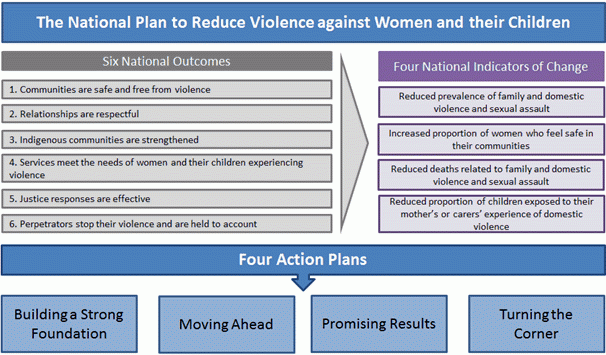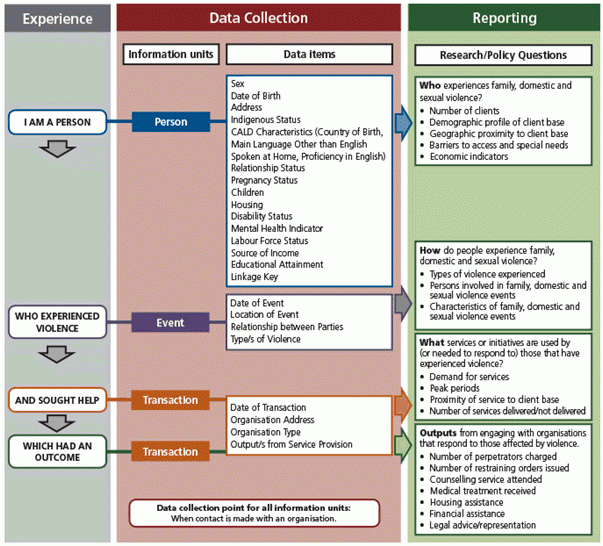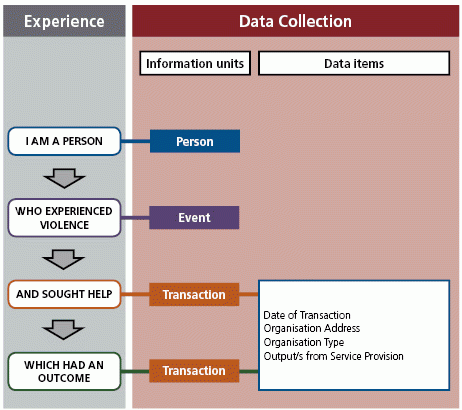Family, domestic and sexual violence causes both human and economic suffering across Australia. Improving the evidence base across sectors and jurisdictions can help enhance understandings about the extent of these issues and provide the basis to make sound policy and service provision decisions.
In providing a solid foundation and evidence base for the reporting of family, domestic and sexual violence, it is essential to focus effort on collecting consistent and comparable data. The Council of Australian Governments (COAG) recognises this through its endorsement of the National Plan to Reduce Violence against Women and their Children (National Plan). The Commonwealth, states and territories are working together to support the National Plan through the evidence building process by committing to and adopting consistent data collection standards in existing administrative processes.
The Australian Bureau of Statistics (ABS) is also committed to producing nationally consistent data to support the National Plan.
Purpose of this publication
The purpose of this publication is to provide an overview of the Foundation for a National Data Collection and Reporting Framework (DCRF) and to act as a guide for organisations about the collection of administrative data in respect to family, domestic and sexual violence. The DCRF identifies the key data items and recording formats required to improve reporting of family, domestic and sexual violence in Australia. It is designed to assist in reporting at different levels; from monitoring of service provision and funding submissions through to meeting requirements for national data collection, analysis and reporting. The aims of the DCRF are to provide:
- a clear, concise and logical structure for data collection activities;
- guidelines for collecting data items to ensure consistent family, domestic and sexual violence reporting; and
- advice to organisations on the implementation of data collection, storage and reporting practices.
The National Plan
The National Plan is a long term approach to reducing violence against women and their children in Australia. It is driven by Six National Outcomes designed to support long lasting change as measured by the Four High Level National Indicators of Change. The National Plan recognises the long term commitment required to achieve these outcomes, and to support this has developed four action plans that all jurisdictions have agreed to work together to implement (Diagram 1).
Diagram 1: The first action plan to support the National Plan to Reduce Violence against Women and their Children
Image

Description
Source: Adapted from the National Implementation Plan: First Action Plan 2010-2013 (FaHCSIA, 2012)
The first action plan - Building a Strong Foundation
The first action plan, Building a Strong Foundation, establishes a solid basis for the National Plan through a number of priority areas. One of these priority areas is a commitment to Building the Evidence Base for family, domestic and sexual violence. There are four activities identified in this priority area (Diagram 2). The ABS was commissioned to implement one of the activities, the development of a National Data Collection and Reporting Framework. This is the third publication in a series of ABS work to establish the Foundation for a National Data Collection and Reporting Framework (DCRF).
The first publication Defining the data challenge for family, domestic and sexual violence, Australia (cat. no. 4529.0) provided a framework for understanding the data complexities in this area. It identified the use of administrative data as a potentially cost effective means of collecting data. The second publication Bridging the data gaps for family, domestic and sexual violence, Australia (cat.no. 4529.0.00.002) built on the first paper by outlining the current data environment for both survey and administrative collections. It also assessed the key data priorities against existing sources and provided recommendations for improvements in administrative data collection.
The focus of the first two publications was on realising the potential of administrative information for more robust reporting within organisations and across the family, domestic and sexual violence service sectors. This publication builds on the information presented in the earlier publications by outlining the DCRF and identifying the key data items for collection in administrative data sets.
Diagram 2: Activities that support Building the Evidence Base
Image

Description
Source: Adapted from the National Implementation Plan: First Action Plan 2010-2013 (FaHCSIA, 2012)
Overview of the Foundation for a Data Collection and Reporting Framework (DCRF)
The DCRF provides the basis for consistent collection of administrative data by organisations in the field of family, domestic and sexual violence. The data items identified in the DCRF are designed to support a stable national framework that is consistent with the reporting needs of organisations, jurisdictions and national programs. A list of key data items are outlined for collecting information about the characteristics of individuals experiencing violence, the incidents of violence (location and the circumstances involved), the types of responses, and the outcomes of these responses for the individuals involved.
Consistent adoption of the data items outlined in the DCRF has the potential to deliver direct benefits to organisations by enabling the production of robust evidence about service provision from their administrative processes. These include being able to:
- evaluate their own procedures and services;
- better understand client needs;
- strategically plan business and service operations;
- make comparisons with similar organisations;
- devise an evidence based business/funding case; and
- report as a service, department, region, or sector, and in the longer term contribute to national reporting initiatives.
Notwithstanding the benefits of consistent data collection practices and standards, the implementation of the DCRF may present significant challenges for organisations. Implementation may require:
- a commitment by management to the DCRF;
- analysis and identification of potential reporting data items;
- operational changes to processes and practices; and
- Information and Communications Technology (ICT) system improvements.
The scope of administrative data that can be made available for reporting purposes is determined by the service provided. Some information that is ideally required for reporting may not be collected by all organisations, particularly when it does not inform service provision. For example a counselling service may ask who the perpetrator was, but may not need to collect a large amount of information about that person. On the other hand, a police officer may collect as much identifying information as possible about a suspect in an effort to gather evidence to proceed with the case. As a result, some information about family, domestic and sexual violence may not be found within all administrative data sets.
With this in mind, the DCRF should be used as a guide for organisations to improve current data capture and recording practices.



